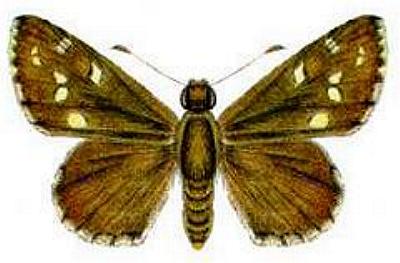
| Spinifex Sand-skipper (previously known as Pasma polysema) TRAPEZITINAE, HESPERIIDAE, HESPERIOIDEA | (donherbisonevans@yahoo.com) and Stella Crossley |

(Picture: courtesy of
CSIRO Australian National Insect Collection)

| Spinifex Sand-skipper (previously known as Pasma polysema) TRAPEZITINAE, HESPERIIDAE, HESPERIOIDEA | (donherbisonevans@yahoo.com) and Stella Crossley |

(Picture: courtesy of
CSIRO Australian National Insect Collection)
The Caterpillar of this species is bluish-green with light and dark lines along the body. It grows to a length of about 2.5 cms. It feeds at night, and lives by day in a tent-shaped shelter made from silk and twisted leaves of its foodplant which may be one of various species of Spinifex Grass ( Triodia, POACEAE ) :
The caterpillar pupates head downward in its shelter.
The adult butterflies of this species are basically brown. They usually have about nine white spots on each forewing on both the upper and the lower surface. The hindwings are brown on top with some faint white spots, but usually have ten definite white spots each underneath. The wings have chequered edges. The butterflies have a wingspan of about 3 cms.
The species has been found in
Further reading :
Michael F. Braby,
Butterflies of Australia,
CSIRO Publishing, Melbourne 2000, vol. 1, pp. 173-174.
Oswald B. Lower,
Descriptions of new Australian Hesperiadae,
Transactions of the Royal Society of South Australia,
Volume 32 (1908), pp. 311-312.
 caterpillar |  butterflies |  Lepidoptera |  moths |  caterpillar |
(updated 19 March 2004, 22 March 2025)